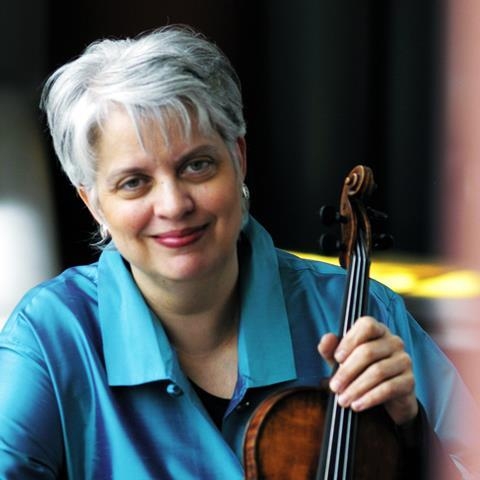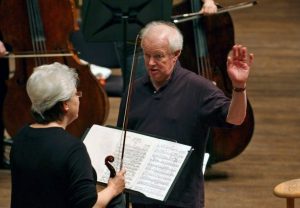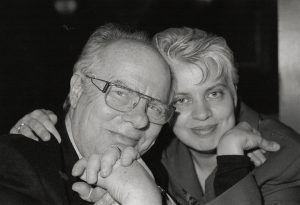
Remembering Jorja Fleezanis (March 19, 1952 – September 10, 2022)
A Rare Gift
In 1982 and 1983, as a student at the San Francisco Conservatory of Music, I had the honor to be among a group chosen to participate in Chamber Music West. This annual festival placed promising young players in ensembles to perform alongside veteran chamber musicians, similar to the model established and sustained at the Marlboro Festival in Vermont beginning in 1951.
In the summer of 1983, I was placed in a Mozart viola Quintet led by Jorja Fleezanis, then the much-admired Associate Concertmaster of the San Francisco Symphony. While Jorja already enjoyed considerable stature by this time, I was the junior member of the group, still completing my undergraduate studies on violin, and in no way ready for prime time. Despite our disparities in status and experience, Jorja showed the same deference to me as the veteran players in the quintet. Jorja’s egalitarian leadership made me feel as welcome and as integral to the rehearsal process as the others. It was a rare gift to receive at 20 years of age, a positive experience that I would never forget.
Breaking Ground
In the years that immediately followed, Jorja was warm, helpful, and encouraging on the few occasions when our paths would cross in San Francisco. We were in different positions, personally and professionally: I was just starting my career, whereas Jorja was a prominent musician, one of only a handful of women players in the country to have a leadership position within a major orchestra.
In 1989, Jorja broke new ground when she joined the Minnesota Orchestra as concertmaster, becoming only the second woman to do so in a major American ensemble. When I joined the Minnesota Orchestra as principal second violin two years later, Jorja and I became direct colleagues.

Which Way is Up?
One of the jobs of principal string players in an orchestra is coordinating the direction of the players’ bows within their section and with the other string sections. This task is challenging and fraught. A string section can sing or choke depending on the choice of bowings.
Inefficient bowing choices can make playing uncomfortable for all, thereby drawing enormous resentment from section players who must follow the bowings as directed. Changing bowings in rehearsal can cost valuable time and annoy everyone present. Although conductors who are string players will sometimes bring their bowings to the orchestra, most rely on the section principals to decide on bowings that optimize the orchestra’s performance and to negotiate and disseminate bowing changes as necessary efficiently.
Thus, bowings can be a thorny problem, and many concertmasters don’t allow much room for negotiation. But from my arrival in Minnesota, Jorja displayed the same warmth, inclusiveness, and open-mindedness with bowings that I had witnessed in my student days with chamber music. She invited us to work together to craft bowings for the orchestra with remarkable collaborative equanimity.
Courageous, Tireless, and Profoundly Empathetic
Over her 20 years in Minnesota, Jorja cemented her reputation as a courageous artist, a tireless champion of new music, and a profoundly empathetic teacher. Jorja and I became friends in the true sense during the four years we were together in Minnesota. I was lucky to be among the many social invitees of Jorja and her husband, critic and author Micahel Steinberg, for evenings of conversation about music, art, literature, and the state of the world over the latest culinary delights they had concocted.

Jorja’s generosity of spirit fostered a friendship that endured even after I left the Minnesota Orchestra to move to Chicago in 1995. We only spoke infrequently but always with genuine affection. It was the kind of relationship that seemed to resume without a hitch, even after long intervals without contact. I imagine that Jorja had many such relationships, simply because she was so remarkable at putting those around her at ease.
In early 2014 I invited Jorja to Chicago to lead a class on historical violinists at Roosevelt University. By then, she had left the Minnesota Orchestra to take a teaching position at Indiana University, and her husband Michael had died. As we reminisced after the class over dinner, I could see that Jorja’s spark and enthusiasm remained intact. It was a memorable evening.
Gone but not Forgotten
Jorja died on September 10, at age 70. When we last spoke a few months ago, I found her to be just as passionate, energetic, curious, and enthusiastic as ever. That recent conversation makes it all the more difficult to imagine that she is gone. Death is often surreal for those who survive, especially when particularly vivid personalities make their exit. Jorja certainly was one of the brightest lights I have known: a dedicated artist, an empathetic teacher, and a soulful human being who touched many lives. She will be remembered and missed.

